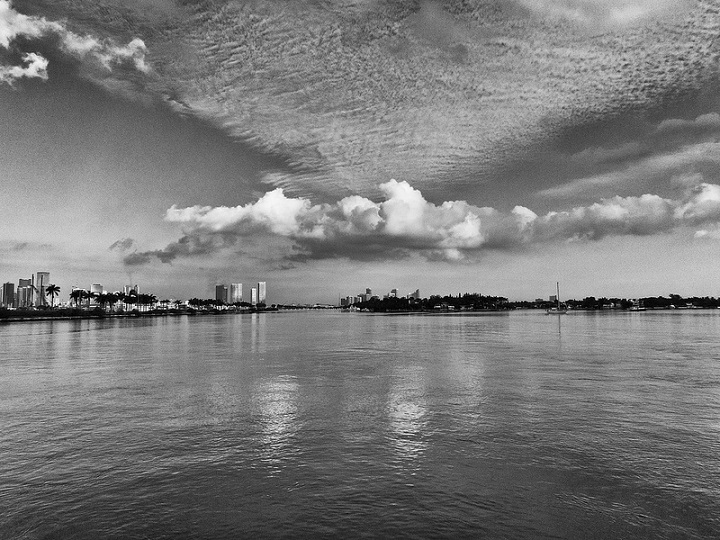The future is bleak for Miami.
Built on low-lying swampland, it’s one of the most vulnerable places on the planet as storms strengthen and seas rise. The city is already suffering from streets that flood at high tide and saltwater seeping into drinking wells. With just a few feet of sea-level rise, which may be unstoppable at this point, most of South Florida will vanish beneath the waves. As a famous Rolling Stone article puts it, Miami is “doomed to drown“, possibly sooner than we think.
Yet the prevailing attitude there seems to be delusional, head-in-the-sand denial. Miami newspapers incuriously note that flooding seems to be getting worse every year, without speculating why. At the 2015 Art Basel fair in Miami Beach, heavy rain swamped parties and exhibitions, and millionaire buyers huddled under tents and waded through flooded streets. And all the while, hot money continues to pour in. The Miami metro area is one of the fastest-growing in the country: new construction is rising at a frantic pace, and multimillion-dollar condos are sprouting at the very edge of the ocean.
Florida’s politicians, if you can imagine it, are even worse. As I’ve written before, its congressional representatives staunchly ignore the problem, while its state government has forbade employees from even using the term “climate change”.
South Florida isn’t the only place staring down the barrel of the future. I’ve mentioned the fascinating story of Hampton Roads, Virginia, both a political nerve center of the religious right and another low-lying metropolitan area at critical risk from sea-level rise. Yet the megachurches and national ministries headquartered there, while they preach about America’s moral crisis, remain stubbornly silent about the seas lapping at their backyards.
In a party captive to vested fossil-fuel interests and anti-science evangelicals, it’s no surprise that most Republican senators are climate-change deniers. But what you may not have known is that they stand virtually alone on this. The modern Republican party is the only major conservative party on earth that rejects the science of climate change.
All this is ample reason to fear for the future of the planet, and I’ve been pessimistic in the past. But since last year, to my surprise, I’ve found my mood turning more and more to optimism. This article sums up the reasons that give me hope:
Those who have consigned the world to its doom should reconsider. The technological and political underpinnings are at last in place to actually consummate the first global pact to limit greenhouse-gas emissions. The world is suddenly responding to the climate emergency with — by the standards of its previous behavior — astonishing speed.
As it points out, solving climate change takes both political will and technological innovation. At worst, this can be a deadlock where the absence of each blocks the emergence of the other: “It is extremely hard to force a shift to clean energy when dirty energy is much cheaper, and it is extremely hard to achieve economies of scale in new energy technologies when the political system has not yet nudged you to do so.” But, given a small push to get over that hump, this can transform into a virtuous cycle where falling costs of clean energy lead to a stronger political push for their adoption, which leads to greater deployment and still lower costs, and so on.
The author argues that this is the pattern we’re now seeing. Renewable energy is booming and prices are plummeting, not just in the U.S. but worldwide. Industries built on fossil fuel are collapsing, especially coal, the dirtiest of them all. Most important, China has committed to decarbonizing, shocking conservatives who argued that it was pointless for the U.S. to cut emissions when the world’s largest country never would. The Paris agreement this year didn’t create these realities so much as recognize them, but it’s still a milestone marking a shift in the world’s attitude toward the crisis.
In the final accounting, preventing climate catastrophe may prove to be less costly than we feared. Conservative thinkers have a long track record of wildly exaggerating the costs and impacts of every environmental regulation. Ironically, it’s those who style themselves the staunchest defenders of capitalism who most consistently underestimate or neglect the power of market forces to respond with innovation. It’s just this kind of innovative explosion we’re now seeing with solar, wind and energy storage. (See also the Cry Wolf Project, which collects dire predictions about the apocalyptic impact of every progressive law, from Medicare to the Clean Air Act to Obamacare.)
This isn’t to say that climate change is a solved problem or that adapting will be painless. Miami and many other cities in coastal areas are still under threat. There will be millions of climate refugees that nations will have to absorb. Countless species will go extinct. Even the amount of warming that’s already locked in could cause severe disruption to civilization, more and worse than our models predict. But this is the first time we can truly say that humanity has heeded the danger and is working to avert it, and that alone is reason for hope.
Image: Miami Beach by John Spade, released under CC BY 2.0 license
